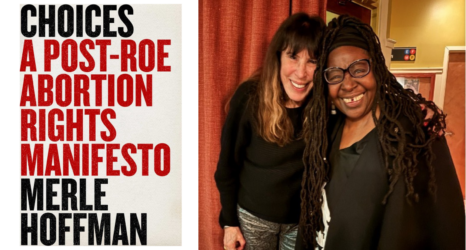In Nagorno Karabakh, Armenians are beginning to rebuild their democracy after military attacks from Azerbaijan and decades of political instability.
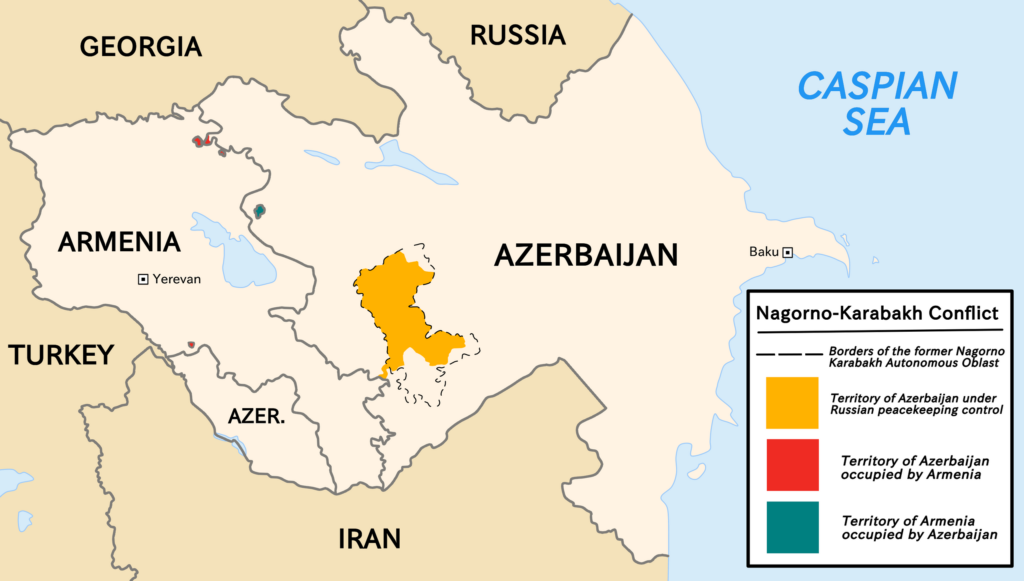
Early on September 27, 2020, Siranush Sargsyan was asleep in her apartment in Stepanakert, the capital of Nagorno Karabakh, a disputed region in the South Caucasus, when she woke to the sound of explosions. She looked out her window and saw smoke. Grabbing her clothes, passport and earrings, she ran to the basement. Tearful women called their families in nearby villages.
“We learned the explosions were everywhere, in every region,” Sargsyan said.
Azerbaijan, backed by Turkey, had launched a massive assault on the mountainous enclave known to Armenians as the Republic of Artsakh, sparking a 44-day war that killed thousands of soldiers and civilians on both sides, and left the fate of the region uncertain.
Outside, people rushed to their cars, preparing to flee. Sargsyan walked to her office in the National Assembly building, where she works as an expert to the Standing Committee on Science, Education, Culture, Youth and Sports. Members of parliament had gathered. Soldiers filled the square.
“Right there, I understood: The country is at war,” she said.
Sargsyan organized women volunteers. They knitted socks, sewed sleeping bags, baked bread and prepared bundles of food, cigarettes and power banks for soldiers. They also obtained military items needed by specific units on the frontline.
When Sargsyan returned to her apartment three nights later to pick up her belongings, a ballistic missile exploded 100 meters away.
“It was dark and so the scene was even more terrible, to see the sky light up red,” she said. The bomb wave shattered the mirrors in her apartment and broke down the door. “We just ran.”
The explosion destroyed a library on the ground floor of her building. Rubble spilled into the street. Amid broken cement blocks and splintered wood, burned books smoldered, the blackened pages curling into ash.
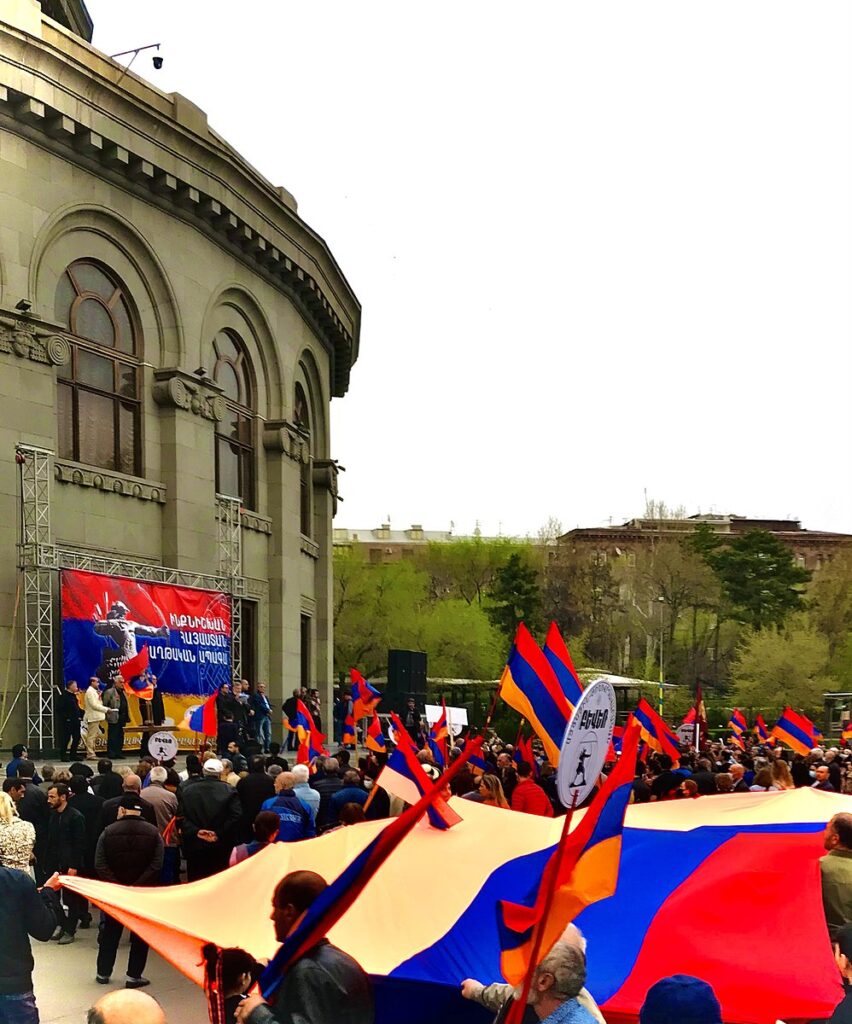
In the days that followed, it became increasingly clear to Sargsyan that it was not safe to remain in Nagorno Karabakh. Azerbaijani forces bombarded residential neighborhoods, killing and displacing Armenian civilians, and destroying vital infrastructure like apartment buildings, schools and a maternity hospital. Even the historic Ghazanchetsots Cathedral was bombed while families sheltered in the basement, and again hours later while journalists filmed the destruction. Azerbaijani forces deployed banned Israeli-made cluster munitions, some of which fail to detonate on impact and inflict suffering on civilians for decades.
Massive craters and mountains of rubble deformed the once vibrant city of Stepanakert. Sargsyan sent her mother, sisters and their children to take refuge in Yerevan, the Armenian capital, and after eight days, the situation became so dire that she joined them.
But she didn’t take a break from work. Sargsyan and other women created the Artsakh’s Voice Matters movement to demand humanitarian aid for the civilians targeted in the attacks, the sanctioning of Turkey and Azerbaijan, and the recognition of the Republic of Artsakh as an independent state. They organized demonstrations outside the American and British embassies and the E.U. and U.N. missions, pledging to remain until someone would meet with them.
Finally, they met with high-ranking diplomats who listened as the women told their stories, but every time, the response was the same: They could not legally intervene. Though the Armenians of Artsakh exercise democratic self-governance free of Azerbaijan’s control, the borders fall within Azerbaijan, and the country’s autonomy has never been recognized by the outside world, including the Republic of Armenia.
“It was painful and frustrating when they say you are not recognized, so we can’t help you,” Sargsyan said. “Like we do not exist.”
A Disputed History
In the early 1920’s, communist rulers incorporated Nagorno Karabakh and its ethnic Armenian majority within Azerbaijan as an autonomous oblast with some degree of self-governance. During the fall of the Soviet Union, Nagorno Karabakh declared its independence, leading to a war between Azerbaijan and Armenia over control of the region.
Sargsyan grew up in Sos, a village in Nagorno Karabakh’s Martuni province not far from the border with Azerbaijan. She was six years old when the first war erupted. Her father and uncle fought against Azerbaijani forces, and when her father returned home periodically, he brought his Kalashnikov assault rifle. Sargsyan wanted to play with it, but her father wouldn’t let her.
By the summer of 1992, it was too dangerous to remain in Sos, so Sargsyan’s family moved to a safer village where her aunt lived. Without any public transportation, they had to walk.
“I was so, so tired but my father was carrying my little sister and my uncle, his son. I lay down on the ground and said I’m not coming, I cannot. My uncle said whoever makes it to the top of the mountain will get his weapon to shoot. I took off and ran up the mountain, my brother and sister followed me. My motivation was the highest, and when we all reached the top, my uncle gave me his weapon. That was my happiest moment.”
Sargsyan never saw her uncle again—he died shortly after returning to the front. Her father, a carpenter by trade, built his coffin. They buried him at night, because it was too dangerous to do so during the day.
In 1994, after Armenian forces won the war that claimed some 30,000 lives, a ceasefire was reached but not a lasting diplomatic resolution, creating a frozen conflict. The region was somewhat stable for 26 years, with periodic clashes, the worst known as the “Four-Day War” in 2016. During this time, landlocked Armenia struggled economically, with the majority of its borders closed.
In 2018, grassroots activists overthrew decades of corrupt leadership in a nonviolent revolution, ushering in democratic values. Meanwhile, for almost two decades, oil-rich Azerbaijan has been ruled by autocrat Ilham Aliyev, who took over the presidency from his father and appointed his wife as vice president. Azerbaijan amassed billions of dollars of high-tech weaponry until their military was so well equipped they believed they would win back the territory in a matter of days, while world powers were distracted by a global pandemic and the American presidential election.
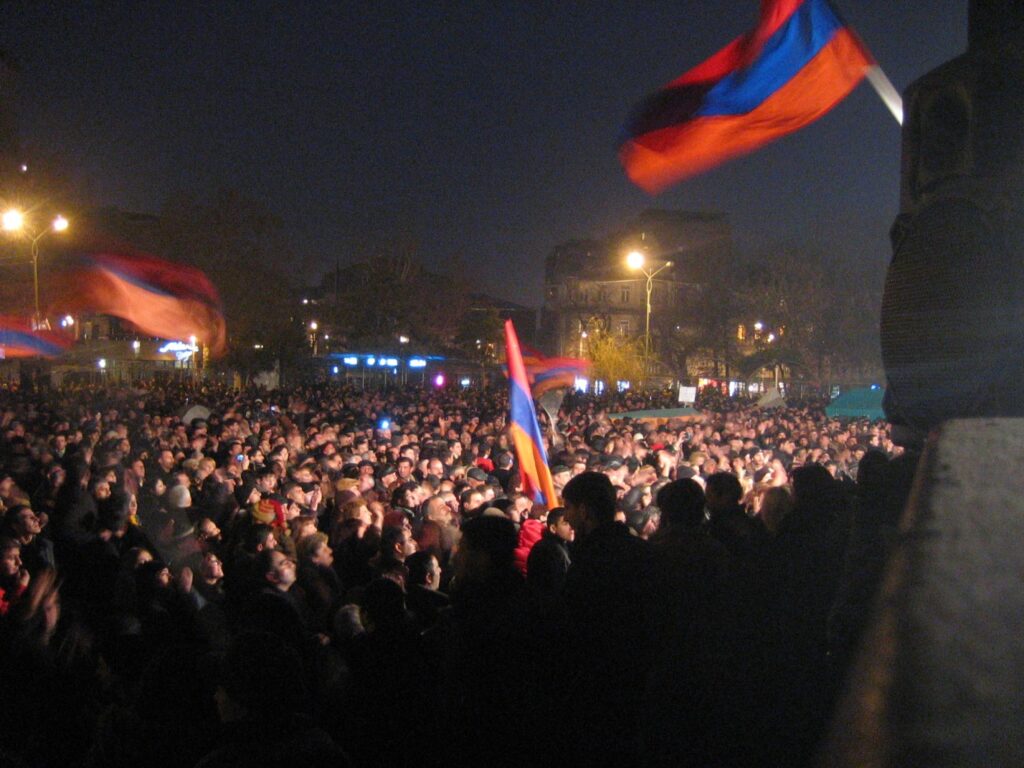
Between demonstrations in Yerevan, Sargsyan returned to Nagorno Karabakh four times during the war, sleeping in basements and hotels. With so many people sheltering in enclosed spaces, the coronavirus spread rapidly.
“When you have so much pain and grief, you couldn’t think about the virus,” she said.
Sargsyan was in Stepanakert when President Arayik Harutyunyan announced on October 29, 2020, that the Azeribaijani forces were approaching Shushi, the country’s second largest city and one with both strategic and cultural significance to both sides. She feared that once the Azeris captured Shushi, they would blockade Stepanakert.
Only days earlier, the nonprofit Genocide Watch had issued a state of emergency, warning that Azerbaijan’s targeting of Nagorno Karabakh’s civilians had reached the highest stages—extermination and denial—in the classification of genocidal development.
“We thought we would be taken prisoner, and knew they would torture us,” Sargsyan said. “I called a man who had a weapon and said if the enemy reaches us, he should kill me.” He refused. “‘There will always be time to die,’ he said.”
Sargsyan returned to Yerevan, where she remained for the duration of the war. Meanwhile, her brother-in-law, who had served in the army’s special forces for 25 years and was fighting at the front, was injured in Shushi. His family could not reach him via cell phone, and his daughter asked Sargsyan to try to find more about his condition and whereabouts. After calling a few acquaintances, Sargsyan learned that when her brother-in-law was wounded, the situation was too dangerous for even other special forces to reach him. Without medical attention, he died.
No one could find his body for over a week. Only after a Russian-brokered ceasefire deal were soldiers able to retrieve half his body, a sight that remains one of Sargsyan’s most haunting memories. She and his mother buried him. “Even his wife and children couldn’t say goodbye.” They had taken refuge in Armenia. “There wasn’t time.”
After six weeks of fighting, and the death of over 6,000 soldiers and scores of civilians, a ceasefire was signed on November 9, 2020. Under the deal, the Armenians of Nagorno Karabakh lost almost three-quarters of their territory. Azerbaijan retained control of the territories it captured during the war, including Shushi, and seven other districts. Two thousand Russian peacekeeping troops were deployed on a five-year renewable basis to ensure safety in the region. A peacekeeping center would be set up in Azerbaijan, jointly run by Russian and Turkish forces, to monitor the ceasefire, and a new route through southern Armenia would connect Azerbaijan to Nakhichevan, an Azeri exclave bordering Armenia, Iran and Turkey.
Armenian Prime Minister Nikol Pashinyan called the settlement the “best solution” given “a deep analysis of the military situation,” but said it was “unbelievably painful for me and our people.”
When Sargsyan heard of the deal, she felt an “incomprehensible hollowness … There was only one feeling: how pointless was the pain we lived through, the horrors we went through for so many days, losses of our kin and, in the end, our homeland.”
“How pointless was the pain we lived through, the horrors we went through for so many days, losses of our kin and, in the end, our homeland.”
Protests erupted on the streets of Yerevan, with people chanting “Nikol is a traitor!” Seventeen opposition groups called on the prime minister to resign, while he accused them of planning a coup. Armenia’s fledgling democracy was suddenly under threat of collapse.
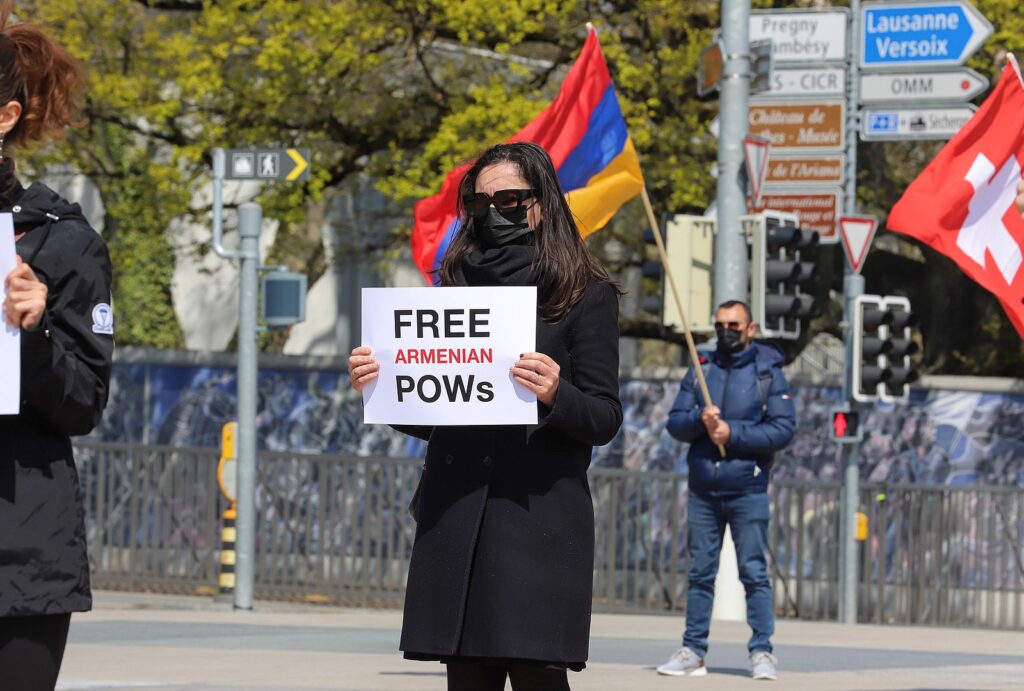
The Impact of War: Displacement and Destruction
According to officials, the war displaced over 100,000 Armenians. Some civilians whose homes weren’t destroyed returned to Nagorno Karabakh, though utilities were down. Many were afraid to return to their homes, now surrounded by the enemy. Tens of thousands who lived in territories now under Azerbaijan’s control were forced to vacate in a matter of days. Some burned their homes before leaving, unable to imagine the enemy sleeping in their beds. Some even dug up the graves of family members, fearing they would be desecrated if left behind. As residents fled, a caravan of cars and trucks filled with belongings stretched for miles, hugging the curves of the mountains that have been home to Armenians for centuries.
Sargsyan returned to Stepanakert, as the city tried to restore electricity and gas.
“I came back to the city and was very depressed without light, in silence,” she said. “And it was strange for me not to hear sirens and bombardments. War is bad, but it is worse when you get used to it.”
Upon returning, Sargsyan guided displaced families through the tedious process of applying for government aid.
“For me the saddest thing is the lines. People come a long way, line up for hours for little help. We are failing in developing a mechanism to correctly and productively get help to people.” Those who lost their homes were given 300,000 drams, or less than 600 dollars, for each family member. But not everyone was eligible to receive this one time payment, and Sargsyan tried to help them in other ways.
Many lost the land they relied on for income. “My family lost our grape and mulberry orchards, our wheat field. I don’t know what they’ll do for a living.”
Armenians are rebuilding against an undercurrent of uncertainty about the safety, status and fate of the territory remaining under their control, still not recognized by the outside world. Despite the ceasefire agreement and presence of Russian peacekeeping forces, Azerbaijan has continued military provocations and refuses to return an unknown number of prisoners of war. Azerbaijani forces have even attempted to advance into the Republic of Armenia, with the most recent attack in July 2021 resulting in the death of three Armenian soldiers.
Amid this instability, many struggle to imagine a future when they are still processing the trauma of losing family members and much of their homeland, have deep distrust in the government, and live in fear of further bloodshed.
“Our future is in limbo,” Sargsyan said.
Still, she’s adamant about remaining, because she believes the only way to revive her homeland is to live in it. But she said the war changed her—her way of thinking, and her carefree and independent nature.
“I feel more responsible for my relatives, for people around me, for my homeland. I’m not just a woman, I’m an Armenian woman. I am a woman of Artsakh.”
Up Next:





